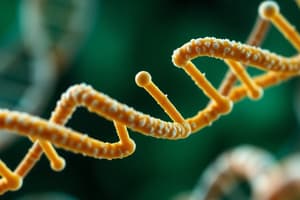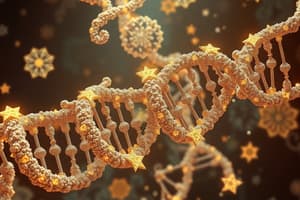Podcast
Questions and Answers
What is the first step in the process of protein synthesis?
What is the first step in the process of protein synthesis?
- Folding of the protein
- Formation of peptide bonds
- Translation of RNA
- Transcription of DNA (correct)
How does messenger RNA differ chemically from DNA?
How does messenger RNA differ chemically from DNA?
- RNA contains thymidine instead of uracil
- RNA is made up of triple nucleotides
- RNA is single-stranded while DNA is double-stranded (correct)
- RNA includes deoxyribose in its backbone
Which chemical bond connects amino acids during protein synthesis?
Which chemical bond connects amino acids during protein synthesis?
- Hydrogen bond
- Peptide bond (correct)
- Ionic bond
- Covalent bond
What happens to the shape of a protein if there is a change in its amino acid sequence?
What happens to the shape of a protein if there is a change in its amino acid sequence?
What is the role of ribosomes in protein synthesis?
What is the role of ribosomes in protein synthesis?
During translation, what is released when a peptide bond forms between two amino acids?
During translation, what is released when a peptide bond forms between two amino acids?
What is the third step in the process of protein synthesis?
What is the third step in the process of protein synthesis?
What does the sequence of amino acids dictate in a protein?
What does the sequence of amino acids dictate in a protein?
What determines the specific shape of a protein in the human body?
What determines the specific shape of a protein in the human body?
Which level of protein structure involves the interaction of side chains of amino acids?
Which level of protein structure involves the interaction of side chains of amino acids?
What could a misplacement of an amino acid in a protein sequence potentially result in?
What could a misplacement of an amino acid in a protein sequence potentially result in?
How do proteins compare to carbohydrates in terms of structure?
How do proteins compare to carbohydrates in terms of structure?
What type of bond connects amino acids in a protein?
What type of bond connects amino acids in a protein?
Which structural feature is NOT typically associated with proteins?
Which structural feature is NOT typically associated with proteins?
What is the significance of the two-dimensional structure level of a protein?
What is the significance of the two-dimensional structure level of a protein?
In what way do the properties of carbohydrates and proteins differ?
In what way do the properties of carbohydrates and proteins differ?
What is the primary function of proteins in the human body?
What is the primary function of proteins in the human body?
How are amino acids significant to proteins?
How are amino acids significant to proteins?
Which statement about the composition of proteins is true?
Which statement about the composition of proteins is true?
What happens when there is too much protein in the diet?
What happens when there is too much protein in the diet?
What characterizes an amino acid's structure?
What characterizes an amino acid's structure?
Which of the following describes the role of proteins in the immune system?
Which of the following describes the role of proteins in the immune system?
How many different proteins are estimated to exist within the human body?
How many different proteins are estimated to exist within the human body?
What can result from insufficient protein intake?
What can result from insufficient protein intake?
Flashcards are hidden until you start studying
Study Notes
Building Proteins
- Building a protein involves three steps: transcription, translation, and folding.
- Transcription is the process of copying genetic information from DNA to RNA.
- RNA is similar to DNA but uses ribose sugar and uracil instead of deoxyribose and thymidine.
- Translation is the process of decoding RNA to synthesize a protein.
- During translation, amino acids are connected by peptide bonds to form a polypeptide chain.
- A peptide bond forms between the carboxyl group of one amino acid and the amino group of another, releasing a water molecule.
- Protein folding is the spontaneous process where the polypeptide chain takes on its three-dimensional shape.
- Each protein has a unique amino acid sequence that dictates its shape and function.
- An incorrect amino acid sequence can lead to a misfolded protein and potentially cause disease.
Protein Structure
- Proteins are polymers of amino acids, just like carbohydrates and lipids.
- Proteins are structurally more complex than carbohydrates and lipids.
- Proteins have four levels of structure: primary, secondary, tertiary, and quaternary.
- Primary structure refers to the linear sequence of amino acids in a polypeptide chain.
- Secondary structure involves the folding of the polypeptide chain into specific shapes like alpha-helixes and beta-sheets due to interactions between amino acids.
- Tertiary structure refers to the three-dimensional shape of a protein, determined by interactions between side chains of amino acids.
- Quaternary structure occurs when multiple polypeptide chains interact to form a larger protein complex.
Protein Roles in the Human Body
- Proteins are essential for various bodily functions, including muscle structure, immune system function, digestion, hair and nail growth.
- It’s estimated that there are over 100,000 different proteins in the human body, signifying their diverse roles.
Protein Composition
- Proteins are macromolecules composed of amino acids.
- Amino acids are the building blocks of proteins.
- Proteins contain carbon, hydrogen, oxygen, and nitrogen.
- The arrangement of elements in amino acids gives them a specific conformation around a central carbon atom.
Studying That Suits You
Use AI to generate personalized quizzes and flashcards to suit your learning preferences.




